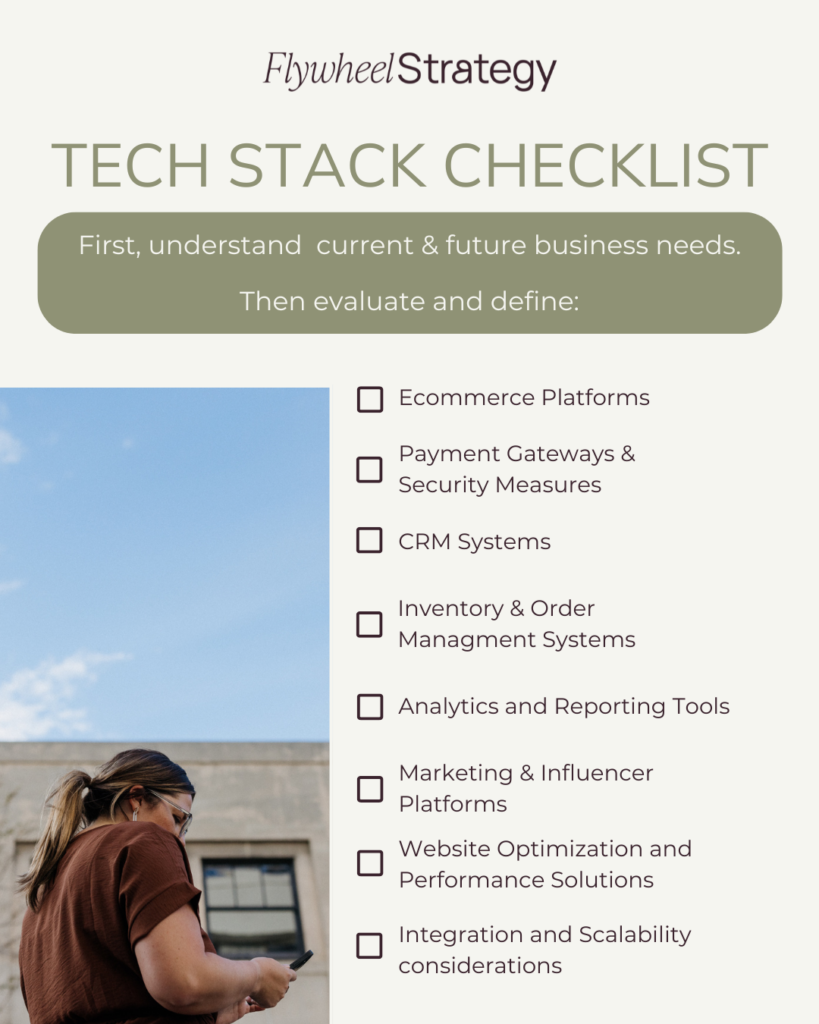WRITTEN BY: KATHRYN LANG
The ecommerce landscape is constantly changing. A robust and well-optimized tech stack is the cornerstone of success. From managing inventory to delivering seamless user experiences, every aspect of your online business relies on the efficiency and compatibility of your technology infrastructure. But your tech stack is not something that you can set and forget. As your business grows and evolves, you need to revisit how and if your tech stack is still working for you.
At Flywheel Strategy, many of our brands are in the midst of revisiting their tech stack and figuring out what exactly is working (or not working) for their current and future business needs. Partnering with Flywheel gives brands peace of mind that not only do they have a trusted partner with years of experience in developing a strong and scalable tech stack, but someone who knows their brand and the goals they are looking to achieve.
Here’s a sneak peek into how the Flywheel team looks at optimizing a tech stack for our ever evolving brands.

Understanding Your Business Needs:
Before diving into the intricacies of your tech stack, it’s essential to have a clear understanding of your business requirements. Define your short-term and long-term goals, target audience, scalability expectations, and unique selling propositions. This understanding will serve as the foundation for evaluating and selecting the right technologies.
Inventory and Order Management Systems:
Efficient inventory and order management systems are the backbone of any ecommerce operation. Evaluate your current systems for their ability to handle inventory tracking, order processing, and fulfillment in real-time. Consider factors like scalability, integration capabilities with other platforms, and automation features to streamline operations and reduce manual errors.
Ecommerce Platform:
The choice of ecommerce platform significantly impacts your business’s performance and flexibility. Assess your current platform for its user-friendliness, customization options, scalability, SEO capabilities, and security features. If you’re using a hosted solution like Shopify, maybe it’s time to review the different plans and look for upgrading opportunities. Ensure that your platform and plans align with your business needs and growth trajectory.
Payment Gateways and Security Measures:
Security is paramount, especially when handling sensitive customer information and payment transactions. Evaluate the security protocols of your payment gateways and ensure compliance with industry standards like PCI DSS. Additionally, consider factors such as transaction fees, support for multiple payment methods, and integration with your ecommerce platform to provide a seamless checkout experience for customers.
Customer Relationship Management (CRM) Systems:
Building and nurturing customer relationships is essential for driving repeat business and fostering loyalty. Assess your CRM systems for their ability to capture and analyze customer data, segment audiences, and personalize marketing campaigns. Integration with your ecommerce platform and automation capabilities can enhance efficiency and effectiveness in managing customer interactions across multiple channels.
Analytics and Reporting Tools:
Data-driven insights are indispensable for making informed business decisions and optimizing your ecommerce operations. Evaluate your analytics and reporting tools for their ability to track key performance metrics such as website traffic, conversion rates, customer acquisition costs, and sales trends. Define where on the data spectrum you and your team are going. From plug and play, immediate insights through tools like Airboxr to digitally comprehensive solutions like Heap, often there’s a multi-pronged approach that serves business needs. ,Leverage advanced analytics techniques like predictive modeling and cohort analysis to uncover actionable insights and drive strategic growth initiatives.
Website Performance and Optimization:
In the fast-paced world of online shopping, website performance can make or break the customer experience. Conduct a thorough assessment of your website’s speed, responsiveness, and mobile-friendliness using tools like Google PageSpeed Insights and GTmetrix. Identify areas for optimization such as image compression, code minification, and server caching to enhance loading times and reduce bounce rates.
Integration and Scalability:
As your ecommerce business grows, so does the complexity of your tech stack. Evaluate the scalability and integration capabilities of your current technologies to accommodate future growth and expansion. Look for modular solutions that can seamlessly integrate with new systems and adapt to evolving business needs without causing disruptions or downtime.
Continuous Improvement and Innovation:
Analyzing your tech stack is not a one-time exercise but an ongoing process of continuous improvement and innovation. Stay abreast of emerging technologies, industry trends, and customer preferences to proactively identify opportunities for optimization and enhancement. Regularly review and update your tech stack to ensure it remains aligned with your business objectives and delivers maximum value to your customers.
Leverage Flywheel Strategy’s expertise where needed, to help analyze your tech stack. It’s a critical component of building and sustaining a successful online business. By understanding your business needs, evaluating existing systems, and prioritizing optimization and innovation, we create robust technology infrastructures that drive growth, enhance customer experiences, and keep your business ahead of the competition in the dynamic ecommerce landscape.
Not sure where to start?
Flywheel Strategy has a Vendor Scorecard that can help you score the multiple vendors you speak with.
Want a copy? Sign up for our Quarterly Newsletter for your copy or connect with us today to learn more.

BE THE FIRST TO COMMENT: